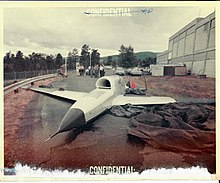Ryan AQM-91 Firefly
| AQM-91 Firefly | |
|---|---|

| |
| Teledyne Ryan AQM-91A Compass Arrow at the National Museum of the United States Air Force. | |
| Role | Aerial reconnaissance unmanned aerial vehicle |
| National origin | United States |
| Manufacturer | Ryan Aeronautical |
| First flight | September 1968 |
| Number built | 28 |
The Ryan AQM-91 Firefly was a developmental drone developed during the Vietnam War to perform long-range reconnaissance, especially into China.
Development
The
Ryan pursued advanced drone concepts on a part-time basis. After discussions with the
Test flights were halted for a few weeks while procedures were reviewed. Flights were resumed, culminating in long-range evaluations in late 1971. Testing concluded with the Model 154 exceeding its altitude requirements and proving almost invisible to radar. However, by this time the need for the Model 154 had vanished. In July 1971, President Richard Nixon began a diplomatic effort to build ties with China, and reconnaissance overflights were cancelled. Satellite reconnaissance capabilities had improved through the 1960s, leading to the first launch of the advanced KH-9 Hexagon satellite on 15 June 1971, which provided strategic intelligence without diplomatic consequences.
The Model 154 program lingered on for a few more years, but in 1973 all were put in mothballs, and scrapped a few years after that. Twenty-eight had been built, including 20 production models.
Design


Stealth
The Model 154 had an engine on the top of the
providing 4,000 pounds (1,815 kg) thrust, with the engine exhaust mixed with cool air to reduce its infrared signature. The YJ97 was derived from a General Electric demonstrator engine designated the "GE1".Avionics
The Model 154 was launched by a
The guidance system was designed to provide navigation accuracies with an error of no more than half a percent. The guidance system proved to be very tricky, and first powered flight of a Model 154 did not take place until September 1968.
Specifications
General characteristics
- Crew: None
- Length: 34 ft 2 in (10.40 m)
- Wingspan: 47 ft 8 in (14.50 m)
- Empty weight: 3,800 lb (1,725 kg)
- Gross weight: 5,400 lb (2,450 kg)
- Powerplant: 1 × General Electric YJ97-GE-3 , 4,000 lbf (18 kN) thrust
Performance
- Maximum speed: 505 mph (815 km/h, 439 kn)
- Range: 2,001 mi (3,220 km, 1,739 nmi)
- Service ceiling: 78,740 ft (24,000 m)
See also
Related development
- Ryan YQM-98
References
- ^ a b Bill Sweetman (May 6, 2015). "Stealth. 80,000ft. $375 Million A Copy. Did We Say This Was In 1970?". Aviation Week.
- ^ "USAF Widens Unmanned Aircraft Effort" (PDF). aviationweek.com/. Retrieved 16 December 2018.
- This article contains material from the Public Domain web article Unmanned Aerial Vehicles by Greg Goebel. (Archived versions of the article: Version 2.0.0, February 1, 2012, and Version 3.0.0, September 1, 2013.)
